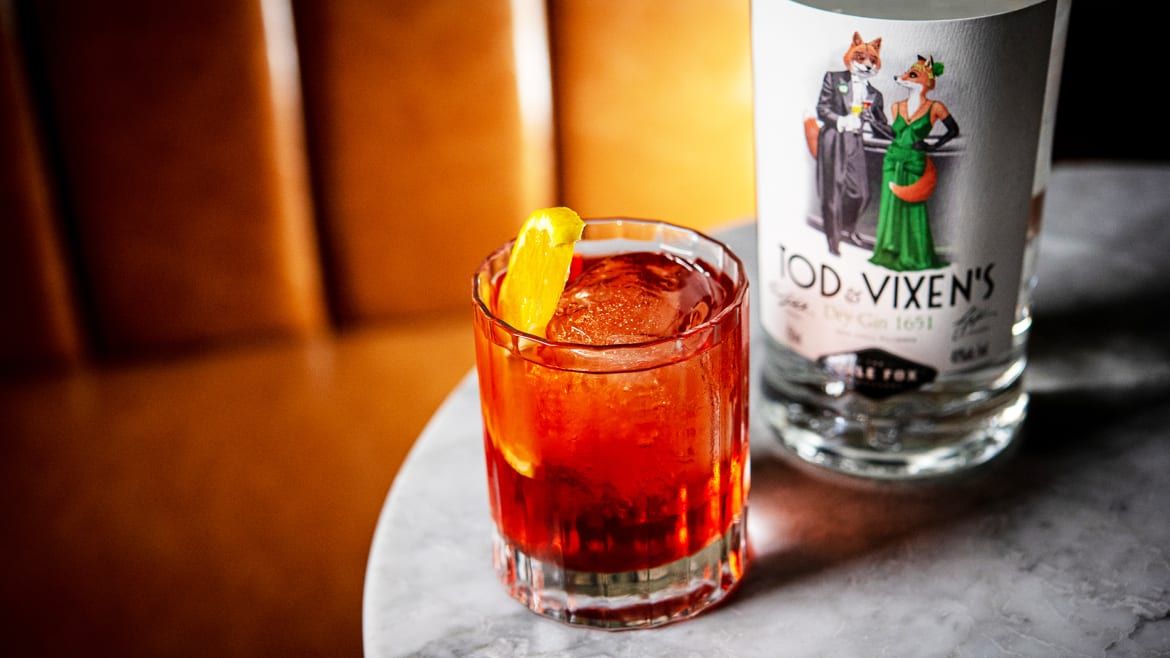
It all started with a cocktail bar napkin.
Four years ago, Eral Gokgol-Kline and his brother Arman decided to meet up for drinks. Over Negronis, Gokgol-Kline sketched out a business plan for a new venture he was contemplating and decided to leave his life in finance behind.
Today, his Negroni-fueled dream comes to fruition as Gokgol-Kline launches both the Vale Fox Distillery and its inaugural spirit, Tod & Vixen’s Dry Gin 1651.
His idea was to make a gin that would work well as the base for a variety of cocktails—but he knew that he didn’t have the distilling or tasting expertise needed to create such a spirit, so he recruited top distilling and bartending talent.
“We started with the premise that 96 percent of gin is consumed in a cocktail,” says Gokgol-Kline. “Then we went backwards from that and said, ‘Okay, we want to think about how this is consumed.’”
He began by recruiting master distiller Roselyn Thomson, who was previously based in the U.K. where she worked at a number of distilleries. Then he brought in Gary Regan, a cocktail legend and author of a number of books, including The Joy of Mixology, as well as the award-winning bartender and Half Full contributor Jeffrey Morgenthaler, who runs Portland, Oregon, bars Clyde Common and Pépé Le Moko, and talented bartender Leo Robitschek, who runs the bars in the three NoMad Hotels (New York, Los Angeles and Las Vegas).
Thomson began by creating a library of around 75 single-botanical distillates to better understand how each ingredient would change in flavor when put through the process of maceration and distillation. She made 30 to 35 gins, which she then narrowed down to four favorites and, at the onset of 2019, began working closely with the trio of bartenders to hone in on a cocktail-friendly flavor profile.
“One thing that was really important to us was that we didn’t want to give [the bartenders] too much information,” says Thomson. “We wanted to get honest feedback from them that wasn’t the same. We then changed or altered things like botanicals, changed maceration time, changed the speed of the distillation to try and work to the feedback we were getting from them.”
In addition to tasting the samples and taking elaborate notes on each one, they would mix each iteration of the gin into a variety of cocktails to see how it performed. Their primary task was to find a gin that stood up to the intense bitter and sweet flavors in a Negroni, but also worked well in a White Lady, a Gin & Tonic and a Martini—no small task.
“I think that the perfect gin should work in all cocktails,” says Morgenthaler. “The home bartender shouldn’t have to have five fucking bottles of gin.”
By the final sample all three bartenders tasted, Morgenthaler says that Thomson had eliminated many of the floral, jasmine-like aspects of the gin in favor of a sharper, more contrasted flavor.
The resulting gin is an amalgam of eight botanicals, including juniper, coriander, angelica and orris roots, red rooibos tea, Makrut lime, and two kinds of orange peel. The botanicals are macerated in neutral spirit made from wheat and well water from the distillery grounds in LaGrange, New York, and then distilled on a 500-gallon copper pot still that was designed by Scottish firm Forsyths.
“This is a very big-flavored gin,” says Regan, of the final Tod & Vixen recipe. “It’s full of juniper, and some unusual woody flavors come through.”
Gokgol-Kline admits that the process of reverse engineering the gin was certainly unusual, but without this approach it’s unlikely that they would have ended up with such a versatile product.
“You know, we did a lot of stuff—we failed a lot,” he says. “We learned from our failures. And to me, failing is very important because if we’re not failing, we’re really not trying.”
While building the distillery and amassing a team, Gokgol-Kline happened upon some surprising family history that’s made his career change seem fateful. His ancestor Jellis Douwse Fonda came to New Amsterdam in the mid-1600s, moved up to New York’s Mohawk Valley and finally settled in a small town near Albany—just over an hour away from The Vale Fox’s 120-acre property.
“We have a document that on October, 19, 1651, the court gave him permission to distill liquor next to the brewery that was already established in that town,” says Gokgol-Kline. “I’m assuming that in 1651 he’s certainly one of the first distilleries in or around there. So now we have a 368-year-old distillery ancestor.”
Gokgol-Kline doesn’t know exactly what his (very) great-grandfather distilled. However, considering that his distillery was located next to a brewery, it’s probably safe to assume he did make some kind of whiskey, as the first step of whiskey distillation is making beer.
As fate would have it, Gokgol-Kline and Thomson are already working on a second offering: an American single malt whiskey. This was also part of that initial plan the brothers sketched out on the Negroni cocktail napkin.
To that end, Gokgol-Kline enlisted a team of industry heavyweights with decades in the biz to work alongside Thomson: the late Dr. Jim Swan, a chemist who worked with the Scotch Whisky Research Institute; Harry Cockburn, who has more than 45 years of distillation experience with brands like Bowmore Distillery; Douglas Cruickshank, the former production director at Chivas Brothers; Arthur Shapiro, the former EVP of marketing at Seagram’s; and Cliff Oldfield, who manages sales for the distillery and previously worked with Pennsylvania’s Dad’s Hat Rye.
Though there is whiskey already resting in barrels at the facility, it will be another few years before it sees the light of day. The Vale Fox Distillery will open to the public later this fall, but until then, you can find Tod & Vixen’s Dry Gin 1651 ($40) at select shops and bars in New York.
How should you drink it? In your favorite cocktail, of course.